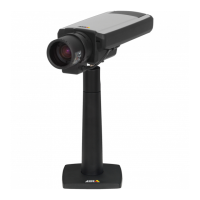
Do you have a question about the Axis Q1604 E and is the answer not in the manual?
| Total megapixels | 1.4 MP |
|---|---|
| Maximum resolution | 1400 x 1050 pixels |
| Supported video modes | 720p |
| Video formats supported | H.264, M-JPEG |
| Analog signal format system | NTSC |
| Camera shutter speed | 1/29500 s |
| Minimum illumination | 0.1 lx |
| Field of view (FOV) angle | 100 ° |
| Sensor type | CMOS |
| Optical sensor size | 1/3 \ |
| Optical zoom | - x |
| Focal length range | 2.8 - 8 mm |
| Normal focusing range | 0.3 m |
| Video motion detection | Yes |
| Built-in HDD | - |
| Compatible memory cards | SD, SDHC |
| LED type | IR |
| Type | IP security camera |
| Placement supported | Outdoor |
| Connectivity technology | Wired |
| Form factor | Dome |
| Mounting type | Wall |
| Product color | White |
| International Protection (IP) code | IP66 |
| Interface | RJ-45 |
| Ethernet LAN (RJ-45) ports | 1 |
| Audio system | 2-way |
| Signal-to-Noise Ratio (SNR) | 40 dB |
| Cabling technology | 10/100Base-T(X) |
| Power source type | PoE |
| AC input frequency | 50 - 60 Hz |
| Cables included | LAN (RJ-45) |
| Operating temperature (T-T) | -40 - 50 °C |
| Compatible operating systems | Windows 7/Vista/XP |
| F-number (relative aperture) | 1.2 |
| Depth | 405 mm |
|---|---|
| Width | 162 mm |
| Height | 142 mm |
| Weight | 3200 g |
Important safety guidelines for product usage and handling.
Information on compliance with various directives and standards.
Guidelines for environmentally responsible disposal and recycling of the product.
Information on how to contact Axis for support and additional resources.
Details on physical components, connectors, and slots like SD card, network, audio, power, and I/O.
Explanation of the Cold Startup Delay Switch, Control Button, and various LED indicators.
Procedures for replacing the lens and setting up iris configuration.
Instructions for accessing the product via a web browser, including IP address and login.
Steps to make the product accessible from the Internet via router configuration.
Guide to setting the administrator root password for secure access.
Overview of controls available on the Live View page for managing streams and actions.
Details on different methods for streaming H.264 video, including protocols and configurations.
Information on using Motion JPEG for video streaming and its characteristics.
Guide to using AMC for viewing and configuring video streams, including its toolbar and settings.
Methods to access video streams using different players and protocols like QuickTime and Windows Media Player.
Initial configuration steps including user, TCP/IP, date/time, video, focus, and audio.
Detailed instructions for manually and automatically adjusting the camera's focus.
Guide on using the Focus Assistant feature for optimal lens focusing.
Configuration options for image appearance, resolution, compression, and frame rate.
How to create, modify, and use predefined stream profiles for different settings.
Advanced image settings including capture mode, color, brightness, sharpness, and contrast.
Features for adding text/image overlays and setting up privacy masks on video.
Configuration of audio modes, input, output, encoding, and sample rate.
How to manage and play audio clips for events or live view.
Options to customize the Live View page layout, viewer, and toolbar.
Configuration of action buttons and output buttons for controlling external devices.
Setting up custom links for scripts or web pages within the Live View.
Configuration for detecting camera tampering events like repositioning or obstruction.
How to set up motion detection windows, parameters, and triggers for alarms.
Configuration for detecting audio levels and triggering alarms based on sound thresholds.
Information on obtaining and installing application licenses and software.
Notes on managing applications during firmware upgrades, restarts, and resets.
Overview of available triggers for action rules, including detectors, hardware, input signals, and system events.
Step-by-step guide to creating action rules for recording, notifications, and other actions.
How to configure recipients for media files and notification messages (email, FTP, etc.).
Setting up schedules and recurrences to trigger action rules based on time or periodic events.
How to play, download, and view properties of recorded videos.
Instructions for configuring the product to continuously save video to a storage device.
Managing user accounts, access levels (viewer, operator, administrator), and anonymous login.
Configuring HTTPS, and network access control like IP address filtering and IEEE 802.1X.
Installing and managing SSL/TLS certificates for secure connections (HTTPS, IEEE 802.1X).
Setting up IPv4/IPv6 addresses, DHCP, static IP, ARP/Ping, and hostname.
Configuring services like AVHS, Dynamic DNS, DNS, NTP, HTTP, HTTPS, NAT traversal, FTP, RTSP, SOCKS, and QoS.
Formatting, mounting, unmounting, and managing SD cards for recording.
Adding and configuring network shares (NAS) for storing recordings.
Performing product restarts, restoring factory default settings, and identifying the product.
Instructions for resetting the product to factory default settings using the control button or web interface.
Steps for upgrading firmware and procedures for emergency recovery if the upgrade fails.
Troubleshooting common issues related to setting the product's IP address.
Solutions for problems like inability to log in or access the product via browser or network.
Diagnosing and resolving problems with H.264 streaming, MJPEG, and general video quality.
Troubleshooting issues related to no audio, poor audio quality, stuttering, and feedback loops.
Resolving problems with storage disruption, video recording, and SD card mounting.
Details on camera models, image sensor, lens, illumination, resolution, and image settings.
Technical details for video streaming, audio streaming, compression, and supported protocols.
Information on network security, supported protocols, API, and system integration.
Details on casing, power, connectors, operating conditions, approvals, and weight.
Factors affecting product performance like bandwidth, CPU load, and client computer capabilities.